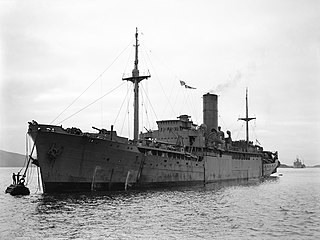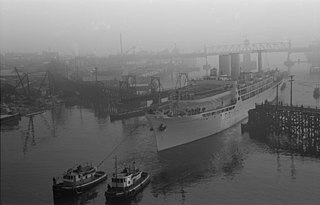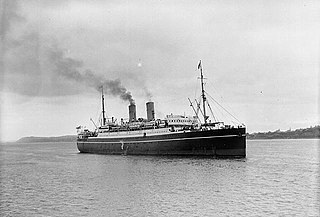
HMS Montclare (F85) was a British ocean liner that was commissioned into the Royal Navy as an armed merchant cruiser in 1939, converted into a destroyer depot ship in 1944 and a submarine depot ship in 1946. She was decommissioned in 1954 and scrapped in 1958.

HMS Port Napier was a British motor ship that was designed and laid down as a civilian cargo ship but completed in 1940 as an auxiliary minelayer for the Royal Navy. An engine room fire caused an explosion that destroyed her in November 1940. Her remains in Loch Alsh in Scotland are now a recreational wreck diving site.

USS Taurus (AF-25), formerly SS San Benito, was a refrigerated banana boat of the United Fruit Company that may have been the first merchant ship to be built with turbo-electric transmission. From October 1942 to December 1945 she was a United States Navy stores ship in the Pacific Ocean theatre of World War II. She was scrapped in 1953.

HMS Forfar (F30) was a British ocean liner that was commissioned into the Royal Navy as an armed merchant cruiser in 1939 and sunk by enemy action in 1940. She was launched in Scotland in 1920 as a transatlantic liner for the Canadian Pacific Steamship Company as Montrose. She was one of three sister ships. The others were Montcalm, also launched in 1920, and Montclare, launched in 1921.

HMS Hector was a UK steam turbine passenger and refrigerated cargo liner launched in 1924. She was the fourth of six civilian ships to bear the name.
SS Manistee was an Elders & Fyffes Ltd banana boat that was launched in 1920. She was one of a numerous class of similar banana boats built for Elders & Fyffes in the 1920s.
SS Automedon was a Blue Funnel Line refrigerated cargo steamship. She was launched in 1921 on the River Tyne as one of a class of 11 ships to replace many of Blue Funnel's losses in the First World War.

HMS Port Quebec was a British motor ship that was designed and launched in 1939 to be the refrigerated cargo ship Port Quebec, but completed in 1940 as an auxuiliary minelayer. In 1944 she was converted into an aircraft component repair ship and renamed HMS Deer Sound. In 1947 she was returned to her owner, Port Line, and completed as a cargo ship. She was scrapped in Taiwan in 1968.

SS Polar Chief was a merchant steamship that was built in England in 1897 and scrapped in Scotland in 1952. In its 55-year career it had previously been called Montcalm, RFA Crenella, Crenella, Rey Alfonso, Anglo-Norse and Empire Chief. Early in the First World War it spent eight months pretending to be the battleship HMS Audacious.
SS Canonesa was a refrigerated cargo steamship that was built in Ireland in 1920 and sunk by a u-boat in the Atlantic Ocean in 1940.
HMAS Orara was a coastal passenger and cargo steamship that was built in Scotland in 1907 and sunk by a mine in China in 1950. She spent most of her career in the fleet of the North Coast Steam Navigation Company (NCSNC) of New South Wales. In the Second World War she was an auxiliary minesweeper and depot ship in the Royal Australian Navy.
HMS Perth was a steamship that was built in Scotland in 1915, renamed Lafonia in 1946 and Valfiorita in 1950, and scrapped in Italy in 1962. She was designed as a coastal passenger and cargo liner, but was completed in the First World War as an armed boarding steamer for the Royal Navy. In the Second World War she was converted into an ocean boarding vessel, and served also as a convoy rescue ship.

HMS Agamemnon was originally the Blue Funnel Line refrigerated cargo ship Agamemnon. She was built in 1929, traded between the UK and the Far East, and was scrapped in 1963. During the Second World War she was converted into an auxiliary minelayer in 1940, and then into an amenities ship in 1943.

HMS Menestheus was originally the Blue Funnel Line refrigerated cargo ship Menestheus. She was built in 1929, and traded between the UK and the Far East. She was an auxiliary minelayer from 1940 to 1943. When the Second World War in 1945, she was undergoing conversion into an amenities ship. She was scrapped in 1953 after being gutted by fire.
HMS Teviot Bank was a Bank Line steamship that was built in England in 1938 as the cargo ship Teviotbank. In the Second World War she was a Royal Navy auxiliary minelayer. By 1956 a Panamanian company had bought her and renamed her Nella. She was scrapped in Italy in 1971.
SS Ruahine was a UK-built ocean liner and refrigerated cargo ship. She was launched in 1909 in Scotland for the New Zealand Shipping Company, who operated her in scheduled service between Britain and New Zealand. She survived both World wars.

SS Metagama was a transatlantic ocean liner That was launched in 1914 and scrapped in 1934. The Canadian Pacific Railway Co owned her and the Canadian Pacific Steamship Co operated her. She was a pioneering example of a "cabin class" passenger ship.
SS Huntingdon was a refrigerated steam cargo liner that was built in Germany in 1920 as Münsterland. The United Kingdom took her as war reparations and sold her to the Federal Steam Navigation Company, who renamed her Huntingdon. She operated between Britain and Australasia until 1941, when an Italian submarine sank her in the Atlantic Ocean.
SS Verdala was a cargo and passenger steamship that was built in Scotland in 1913. Several times she changed owners and was renamed: as Mongolian Prince in 1917, Istok in 1928 and finally Maycrest in 1940.
SS Manchester City was a British cargo steamship that was built in Glasgow in 1937 and scrapped in Faslane in 1964. The Royal Navy requisitioned her in the Second World War.











